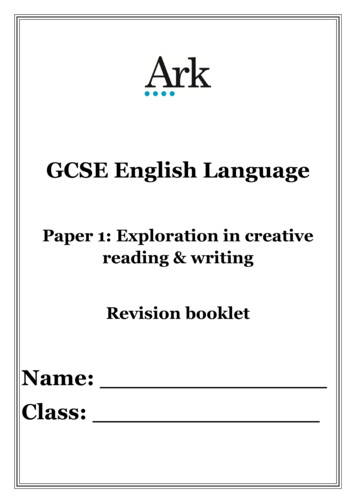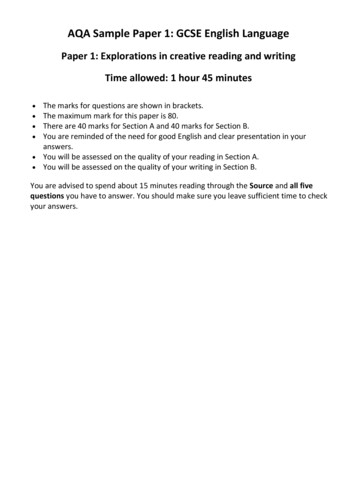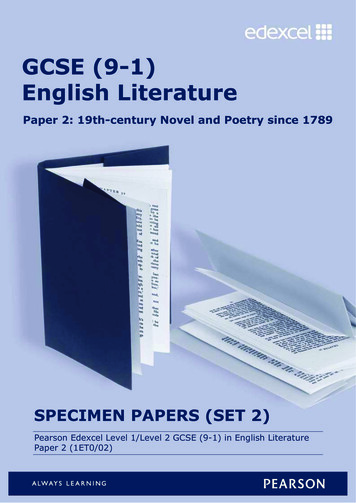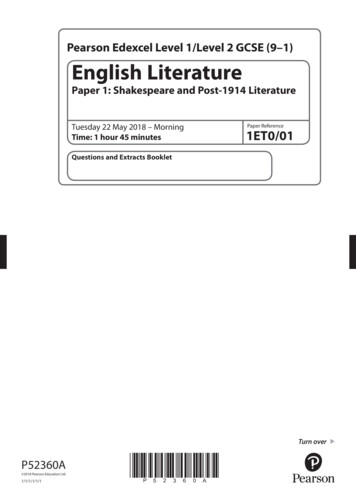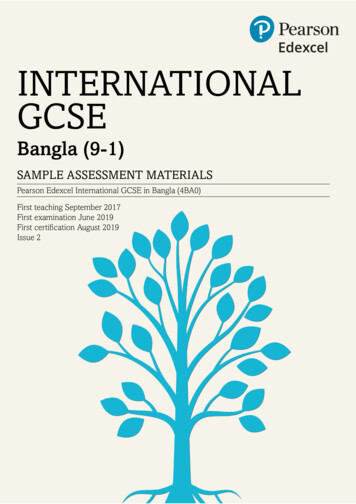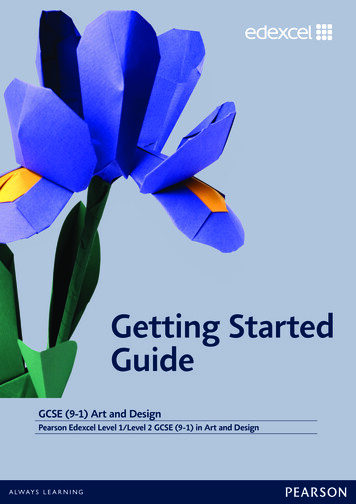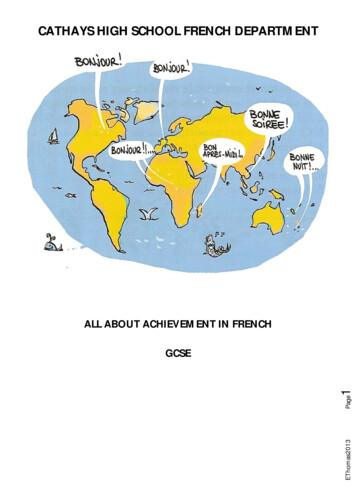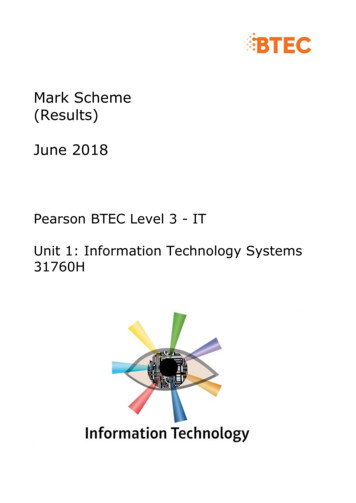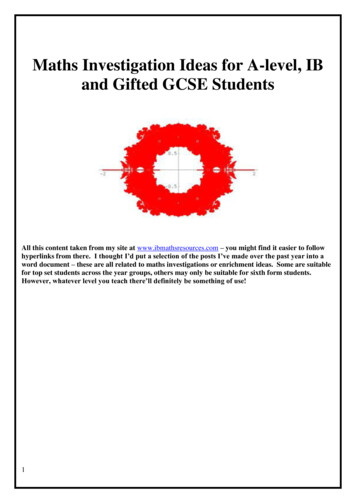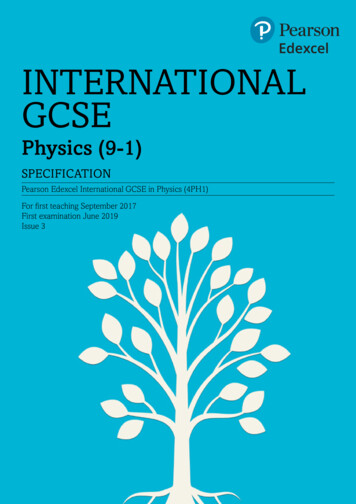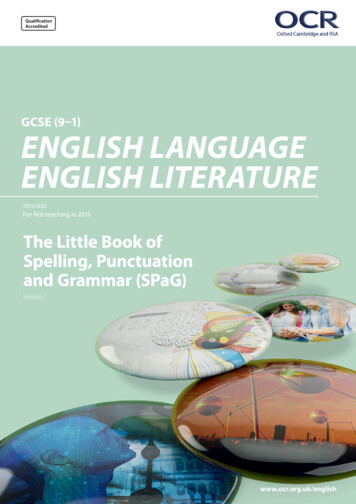
Transcription
QualificationAccreditedGCSE (9–1)ENGLISH LANGUAGEENGLISH LITERATUREJ351/J352For first teaching in 2015The Little Book ofSpelling, Punctuationand Grammar (SPaG)Version 1www.ocr.org.uk/english
GCSE (9–1) English Language and English LiteratureThe Little Book of Spelling, Punctuation and Grammar (SPaG)This guide has been written by Frank Danes.It contains interactive activities which you canaccess at:http://english.ocr.org.uk/course/view.php?id 144You will be required to login as a Guest User usingthe following login details:Username: spagPassword: spagspag2 OCR 2016
GCSE (9–1) English Language and English LiteratureThe Little Book of Spelling, Punctuation and Grammar (SPaG)IntroductionIntroductionThis little guide is intended as a handy reference tool forstudents and adults.Making mistakes in English does not make you a badperson and is not morally wrong. Winston Churchill,one of our greatest statesmen and writers, asked hispublishers in 1933 to help correct his “questionable”grammar, repetition, and dull, boring passages. He wasalso troubled about his use of hyphens. *English is a tricky, confusing and constantly changinglanguage, governed erratically by apparently arbitraryrules upon which not even grammarians or Englishteachers can agree. Sometimes, for example, alternativeuses are equally correct: “focused” can be spelt with ones or two: “focussed”. No wonder we all make mistakes inour English.Our hope, though, is that this little guide will helpyou to avoid some of the pitfalls of English. There arealternatives to some of the usages given but the usagesin this guide do represent one correct usage, evenamong the equally correct alternatives.English spelling is notoriously odd and we have notnecessarily benefited from the American nineteenthcentury practice of regularising our spelling. Gnat has asilent g because the g was sounded in Chaucer’s time –the fourteenth century – but why does it still have the gwhen we haven’t sounded it for hundreds of years? Whyshould traveller have an extra l when travel has one? Whyshould humorous drop the u of humour?The guide is ordered alphabetically to make it as easy aspossible to use, rather than putting grammar, spellingand punctuation in separate sections.*see Roy Jenkins, Churchill, p.450(Macmillan, London, 2001)As for grammar: does someone feel disorientated ordisoriented? (“Disorientated” is British English but“disoriented” is American English.) Should you sendsomeone an invitation or an invite? (“Invitation” is usuallypreferred as the noun but “invite”, usually the verb, wasused as a noun from the nineteenth century.) And do yougive a quote from Shakespeare or a quotation?Language changes all the time. We can tell this by thefact that we no longer speak Middle English, OldEnglish, Anglo Saxon, Latin, or - going even furtherback – Cro-Magnon grunts. Yesterday’s bad usageis today’s correct grammar. Fifty years ago, itwas correct usage to write “to-day” and “tomorrow”. “Today” and “tomorrow” – withoutthe hyphens - are imported Americanisms,but no-one would dream of using thehyphenated, but British, versions now.We must beware of being told that suchand such is “correct” grammar: answering“It is I” to the question “Who is that?” isperhaps only correct if we want to soundlike Jane Eyre. As language changes everyday, the best we can do is record what iscurrently considered acceptable usage andnote the alternatives.3 OCR 2016
GCSE (9–1) English Language and English LiteratureThe Little Book of Spelling, Punctuation and Grammar (SPaG)ContentsContentsAbbreviations5Inverted commas18Advise and Advice6–ise or –ize19Affect and Effect6It’s and its19A Lot6Less and Fewer20Apostrophes6License and Licence21Blond or Blonde9Like and as though21Brackets10Lists21Capital Letters10Lose and Loose21Colons and Semi-colons11Mr, Mrs, Ms and Miss22Commas12Numbers22Dash and Hyphen14Of or Have?23Different from14Of and Off23Effect15Paragraphs24E.g. and Etc. and i.e.15Parenthesis24Fewer15Plurals of words ending in –y24God or god?15Practise and Practice25Hanging and Hung15Program and Programme25He, she or they?16Quote and Quotation26Homophones17Quotations: punctuation of quotations 26I, me or myself?17Split infinitives28I.e.18Too and To28Infer and Imply184 OCR 2016
GCSE (9–1) English Language and English LiteratureThe Little Book of Spelling, Punctuation and Grammar (SPaG)AbbreviationsAn abbreviation is a shorter form of a word.Another common abbreviation is the straightforwardshortening of a word (or words):A common form of abbreviation in English is the elision:a word in which the vowel is omitted. Prof. professor Dr. doctorSo Do not becomes don’t Mr. mister Rev. reverend Cannot becomes can’t Rt. Hon. Right Honourable Will not becomes won’t Etc. et cetera. Is not becomes isn’t Should not becomes shouldn’tIt is usually considered correct to end suchstraightforward abbreviations with a full stop. The full stopindicates to the reader that this is an abbreviation. (Thefull stop is optional with titles like Dr, Mr, Rev, Prof.)and so on. An apostrophe is used to show where thevowel and other letters have been left out. You shouldavoid using elisions when writing formal English – forexample, an academic essay or a formal letter:E.t.c. for “etc.” is a common mistake.A third form of abbreviation is the shortening of aninstitution, job title, company etc. by its initial letters:I’m sorry that I’ve not applied for the jobis not considered as correct as BBC British Broadcasting Corporation ITV Independent TelevisionI am sorry that I have not applied for the job. MP Member of Parliament MSP Member of the Scottish Parliament CBI Confederation of British Industry.Similarly, it is preferable to use the full form of someabbreviations – etc., e.g., i.e. – when writing formalEnglish. So, write: It used to be considered correct to add a full stop aftereach letter to show that these were abbreviations (M.P.)but it is quite correct, and more common, not to bother.And so on rather than etc. ( Latin, et cetera,meaning “and so on”)For example rather than e.g. ( Latin, exempli gratia,meaning “for example”)That is rather than i.e. ( Latin again, id est, meaning“that is”).If you (must) end a sentence with an abbreviation, it is,strictly speaking, correct to use two full stops: one for theabbreviation and one for the end of the sentence:won’t disn’on’ttr. D wou can’tldr. The shop was crammed with pens, pencils, tinopeners, shoelaces, milk, greetings cards, foil, mugs,etc.However, your computer may object to two full stops andsubstitute one full stop only. This is increasingly acceptedas correct punctuation for ending a sentence with anabbreviation ending in a full stop.5 OCR 2016
GCSE (9–1) English Language and English LiteratureThe Little Book of Spelling, Punctuation and Grammar (SPaG)Advise and AdviceSee Practise and PracticeAffect and EffectAffect is a verb: to affect Ben’s strange behaviour began to affect the wholeclass, who also started to moan and gibber. Clara’s sad story affected him deeply and he began tocry.However, there is also a verb to effect (spelt with an e),which means, to bring about: Abanazer had to effect a change quickly, so heswapped the new lamp for the magic lamp whenAladdin wasn’t looking. Some voters were fed up with the Coalitiongovernment, so they effected a change by voting fora Conservative one.Effect is a noun: the effect The effect of drinking so much sugary tea was tomake Rory over-excited. One effect of Santa’s cutbacks was a rise in thenumber of unemployed elves.The verb to effect is, however, not often used. Foreveryday English, it is a safe rule of thumb to rememberthe mnemonic:The phrase “special effects”, often seen at the end oftelevision programmes and films, might help youremember that effect with an e is a noun.Affect is the verb which begins with an A,But special effects start with E, they do say.A lotThe verb “allot” is one word, however, and means, to giveout. It is the root of the word “allotment”, where peoplego to grow their own produce, and literally meanssomething given out by the council: here, an area of land.“A lot” is two words, although a lot of people spell it(incorrectly) as one word (alot).“A lot” is not particularly interesting or elegant a phraseanyway so you could use an alternative, such as: anumber, many, some, a majority etc.“To allot” is not to be confused with “a lot”.ApostrophesApostrophes are tricky and it’s unlikely that more thanone in four adults, let alone students, uses them correctly.George Bernard Shaw argued we should therefore get ridof them completely, and his plays often exclude them.Those things over there are my husband’s. (i.e., Thosethings over there belong to my husband.)or:Those things over there are my husbands. (i.e. Myhusbands are those ghastly objects over there.)On the other hand, apostrophes can enhance and clarifymeaning. The writer Kingsley Amis was asked for anexample of a sentence whose meaning would changewith the addition of an apostrophe. Amis thought for a bitand came up with:Like them or not, we are stuck with them. Mistakeswith apostrophes and comma splicing (using a commainstead of a full stop at the end of a sentence) are said tobe the two things which annoy English Language GCSEexaminers more than any other English mistake. For thatreason alone, it’s worth students using them properly.6 OCR 2016
GCSE (9–1) English Language and English LiteratureThe Little Book of Spelling, Punctuation and Grammar (SPaG)Apostrophes are used for two purposes:1. To show that letters have been left out oromitted: don’t, can’t, isn’t, couldn’t, they’re2. To show possession or ownership:Sasha’s belt; Simon’s lawnmower; the waitress’s trays;the waitresses’ traysApostrophes are never used to make plurals. Thisis the most common mistake with apostrophes. (It issometimes known as “The Greengrocer’s Apostrophe”as greengrocers are allegedly more guilty than othervendors of using the apostrophe wrongly to makeplurals.) ThusApple’s 70p a lbis completely wrong. So isThe cat’s drank their milkandThe horse’s enjoyed their outing.1. Use an apostrophe to show letters, or a letter,have/has been missed out:Do not becomes don’t (the o is left out)Cannot becomes can’t (the no is left out)and so on. (Words in which the vowel is left out arecalled elisions.)The apostrophe goes where the missing letter shouldbe, and not where two words join. So:Do’nt is wrongSo is should’nt.2. The apostrophe for possession: to showownershipThis is the rule that gives people most trouble, so heregoes.The apostrophe shows that one thing belongs tosomething else: ownership or possession. If we werebeing long-winded, we could write:The hat of the horse.But it is much easier and simpler to write and say:The horse’s hat.The rule for using the apostrophe for ownership is thatthe apostrophe goes after the owning word.7 OCR 2016
GCSE (9–1) English Language and English LiteratureThe Little Book of Spelling, Punctuation and Grammar (SPaG)The owning word is the word doing the owning.It is usually a safe rule of thumb that:InThe apostrophe before the s shows a singular owningwordThe horse’s hatandthe horse is doing the owning: therefore, horse is theowning word.The apostrophe after the s shows a plural owning word:The rule the apostrophe goes after the owning wordhelps when we want to show plural nouns owningsomething (plural more than one).The carpet’s bloodstains (one carpet)ThusThe carpets’ bloodstains (more than one carpet).The teeth of the dinosaur (singular)Problems with apostrophesbecomes1. Problems sometimes arise with using the apostrophefor possession with plural nouns that end in –ies. Youcan’t writebutThe dinosaur’s teeth.The apostrophe goes after dinosaur, the owning word.So dinosaur must be singular.The babie’s foodbecause the owning word would then be “babie” andthe singular spelling is “baby”. So the apostrophe for thisexample must go after the s of “babies” as two or morebabies own the food:But if we want to writeThe teeth of the dinosaurs (plural)in a more usual way, the apostrophe still goes after theowning word – dinosaurs – and we get:The babies’ food.2. James’ books or James’s books?The dinosaurs’ teeth.Which is correct? Actually, both are. The former is a littlemore old fashioned, but still correct.The position of the apostrophe thus tells us whetherthe owning word is singular or plural, because theapostrophe goes after the owning word. ThusIt is a safe rule of thumb that, if the second s is sounded,then it should be written down.The fridge’s contentsThusis singular butJesus’ storiesThe fridges’ contentsis perfectly correct but might sound like “Jesus stories”when read; it is confusing because it doesn’t clearlyindicate the intended pronunciation.is plural.Confusion sometimes arises because singular and pluralowning words can sound the same (words that sound thesame are called homophones). The singular “the fridge’scontents” sounds exactly the same as the plural “thefridges’ contents”. We can’t tell how many fridges there arefrom hearing the words, but we can from seeing wherethe apostrophe goes when the phrase is written down(always after the owning word).Jesus’s storiesmight be better punctuation because it more clearlyindicates there is a second s to be pronounced.8 OCR 2016
GCSE (9–1) English Language and English Literature3.The Little Book of Spelling, Punctuation and Grammar (SPaG)Apostrophes to show separationseparation does not always make anything clearer to thereader, whereas, say, the possessive apostrophe does.A third use of the apostrophe, which is rapidly going outof fashion, is to show separation. We might writeThe 1970’sAn exception is using the apostrophe for separation withplurals of letters, which can make the meaning clearer:with an apostrophe to show the separation between thenumerals and the letter. Similarly, we could writeThere are two o’s in “moose”is clearer thanM.P.’sThere are two os in “moose”.as the plural of M.P., using the apostrophe to show thedifference between the abbreviation (M.P.) and the“ordinary” writing, the letter s. (However, since the fullform is “Members of Parliament”, the abbreviation shouldlogically be M’s.P. But English rules are not always basedon simple logic.)Test YourselfHave a go at correcting the use ofapostrophes in different sentences bycompleting the Use of apostrophesactivity.To access the activity you need to login as a Guest User using the followinglogin details:Username: spagPassword: p?id 10145However, it is perfectly correct – and simpler – to writeThe 1970sM.P.s (or even to drop the full stops: MPs).Most people no longer bother using apostrophes toshow separation, perhaps because pointing out suchBlond or Blonde?As in French,The male – masculine – is spelt blondThe female – feminine – is spelt blonde.ThusJohn has blond hairbutCathy has blonde hair.9 OCR 2016
GCSE (9–1) English Language and English LiteratureThe Little Book of Spelling, Punctuation and Grammar (SPaG)BracketsSee Dash and HyphenTricky exceptions: Seasons of the year don’t use capital letters: spring,summer, autumn, winter It’s optional to use capital letters for points of thecompass: north, south, east, west or North, South,East, West “My birthday” doesn’t take a capital letter, eventhough it is a special day for me, although “MyWedding Anniversary” can be written with capitalletters. (Irritating, isn’t it?)In more detail:1. In British English, small words in titles (of films,television programmes, newspaper headlines etc.)don’t usually take a capital letter:“Pride and Prejudice”New Leader of the Labour Party Elected“Pirates of the Caribbean”Stratford-upon-AvonMarks and Spencer.Capital LettersCapital letters are used for: the first word in a sentence the first person pronoun “I” days of the week months of the year special days of the year (Christmas Day, New Year’sDay) names of places of entertainment (The AlmeidaTheatre, Odeon, Old Trafford) shop names (Sainsbury’s, Aldi) titles of books, bands, films, television programmes,songs, plays, poems, novels particular nouns (my Mother [particular noun] butanyone’s mother) proper nouns, that is:– people’s names– nicknames– street names– towns– counties– countries.2. Capital letters are used for particular nouns but notgeneral nouns.My Dad is a particular noun, because I amdistinguishing between my Dad and anyone else’s dad.“Everybody’s dad loves knitting”: here, dad is a generalnoun because it means everyone’s dad, as distinct frommy Dad. So:My Uncle (but everyone’s uncle) forgets my birthday.My Mother (but everyone’s mother) didn’t much enjoychildbirth.Please, Dad, can I have another twenty quid? Everyoneelse’s dad has paid up.My Aunt has invited me to stay, as is the way with aunts.Strangely, some words like sister and brother – mybrother, my sister – don’t take capital letters, althoughthey can be particular nouns.10 OCR 2016
GCSE (9–1) English Language and English LiteratureThe Little Book of Spelling, Punctuation and Grammar (SPaG)Colons and Semi-colonsColons and semi-colons, like full stops and commas, arepunctuation marks that indicate a pause. Punctuationis in part a system of pauses to help the reader to makesense of what she or he is reading.Both groups of words are sentences as they make senseon their own. However, we could join them with a semicolon:He threw away his smelly socks; he went for a jog in freshones.If a comma is a short pause to take a breath,And a full stop is a long pause to take a deeper breathThen a colon is a pause to take a medium breath,And a semi-colon is a pause to take a deeper breath.*Note that there is no capital letter after the semi-colon,when there is, of course, one after a full stop.(*Some would say a colon or semi-colon is a pause aslong as a full stop. It is actually very hard to measure.)Unlike sentences which contain a colon (:), there is nostrong link in meaning – such as, an ironic link – betweenthe two parts of the sentence before and after the semicolon.We could express the pauses as musical notes:Comma,Semi-colon;Crotchet(one beat)Minim(two beats)Colon:Full stop.Why bother to use semi-colons? Basically, for varietyand sometimes clarity. Interesting writing containsshort sentences, long sentences, medium sentences,simple sentences and complex sentences. Semi-colonsenable writers to add spice and interest to their writingand readers love variety. Dickens could write over 600words without using a full stop because he employedthe full range of alternative punctuation, including thesemi-colon, and he was a master of witty and wonderfulwriting.MinimSemi-breve(two beats) (four beats)The important point to remember is that colons andsemi-colons are pauses in your sentence. Some writersscatter them around all over the place like confetti, whichis wrong if it disrupts the natural rhythm of the sentence.A good tip is to read your sentence aloud after you’vepunctuated it: do the pauses sound right for the sentenceor do they disrupt its rhythm?Use of the colon (:)The colon has two uses:Use of the semi-colon (;)The colon shows that something is to follow: often a list.A semi-colon is called a semi-colon because it is half(semi) a colon. It has the top dot but not the bottom dot:For example:; semi-colonA. My sister told me to buy the following: a drill; aleather jacket; a pair of false teeth and a green bucket.B. She said:“I’m not surprised you don’t understand. You’reclueless.”: colon.People confuse the semi-colon with the colon, not leastbecause they look like each other.In A, the colon is used to introduce a list. In B, the colonis used to introduce the woman’s speech. (If “she said” or“he said” is on the same line as the words said, then thewords said are preceded by a comma. If you start thewords actually said on a new line, use a colon. The useof the colon in B also introduces a pause and a sense ofanticipation which would not be gained by a comma.)The semi-colon is used to join two groups of words whichcould make sense as sentences on their own.For example:He threw away his smelly socks. He went for a jog in freshones.11 OCR 2016
GCSE (9–1) English Language and English LiteratureThe Little Book of Spelling, Punctuation and Grammar (SPaG)The second use of the colon is to imply a strongrelationship between the group of words before thecolon and after the colon:Items in a list are joined with a comma if each item in thelist is only one or two words long:Do not climb on the following: walls, fences, trees,furniture, chairs or grandpa.For example:C.He got the job in spite of his poor qualifications: hisMother was the manager.D.I will not buy this table: it is scratched.Items in a list are joined with a semi-colon if each item inthe list is more than two words long:To build a vampire trap, you will need: garlic; aconsecrated wafer; Holy Water blessed by a RomanCatholic priest; a cross; a magic circle of blood or chalk;iron and a wooden stake.In example C, the colon is used to indicate an ironicrelationship between the two halves of the sentence:the reason he got the job was because of favouritism onthe part of his mother. In example D, the second half ofthe sentence tells us more about the first half: here, thereason why he wouldn’t buy the table.Note: there is no comma or semi-colon before the lastitem on the list if it is preceded by words like “and” or “or”.If most of the items in the list are more than two wordslong, but some are only one word long (as in the exampleabove), use a semi-colon to separate them.In both examples, the colon creates a pause and a senseof anticipation for the reader. The reader wants to knowwhat is coming next.If most of the items in the list are one or two words long,and only a couple are longer than one or two words, usea comma to separate them.(Note: colons and semi-colons are tricky and somepeople find them too confusing to use. A dash ( –) canbe used as an alternative to the semi-colon and colon inall the examples above. However, a dash can’t be used asan alternative to the colon and semi-colon in lists (seebelow).Test YourselfListsLists are introduced with a colon:You will need: a mixing bowl; self-raising flour; two eggsand some raisins.Have a go at adding a comma, a semicolon or a full stop in the middle ineach sentence by completing the Useof commas and semi-colons activity.To access the activity you need to login as a Guest User using the followinglogin details:Username: spagPassword: p?id 10147CommasCommas are short pauses which allow the reader totake a breath and to make sense of a sentence. They markthe natural pauses in a sentence:for a full stop. Using a comma when you need a fullstop is called comma splicing. Comma splicing is a verycommon error. The other is mis-use of the apostrophe. Ben pounded down the street, crying as he ran. Vicky counted out the woman’s change, found it wasshort and rooted around for another twenty pence.The trouble with comma splicing is that it doesn’t givethe reader enough pause to take a breath. Reading apassage which is comma spliced ignores the naturalrhythm of writing and can leave the reader breathless andexhausted:Commas are shorter pauses than a full stop (.), colon(:) or semi-colon (;).In an arm-chair, with an elbow resting on the tableand her head leaning on that hand, sat the strangestlady I have ever seen, or shall ever see, she wasdressed in rich materials – satins and lace and silksNot least because commas are shorter pauses thanfull stops, a comma cannot be used as a substitute12 OCR 2016
GCSE (9–1) English Language and English LiteratureThe Little Book of Spelling, Punctuation and Grammar (SPaG)The sentence makes sense without the words marked offby the commas (“who was very territorial”):Steven resented having to give up his cabin to anotherpassenger.In the complete sentenceSteven, who was very territorial, resented having to giveup his cabin to another passenger.the words inside the commas give extra information inaddition to the main part of the sentence. At the sametime, the commas preserve the natural pauses andrhythm of the sentence.Thus commas here work as a parenthesis (like brackets:see Dash and Hyphen, below).3. The word “and” does not usually take a comma in frontof it:Simon liked Peter, Bill and Colin but disliked Tom andPatrick.4. Commas are used to separate items in a list when eachitem is only one or two words in length (see Colons andSemi-colons, above):Ian stared in dismay at the list of exercises he had tocomplete this morning: push-ups, squat thrusts, a jog,weight-lifting and forty lengths of the swimming pool.– all of white, her shoes were white, she had a longwhite veil dependent from her hair and she hadbridal flowers in her hair, but her hair was white,once, I had been taken to see some ghastly waxworkat the fair, once, I had been taken to one of our oldmarsh churches to see a skeleton in the ashes of arich dress, that had been dug out of a vault underthe church pavement, now, waxwork and skeletonseemed to have dark eyes that moved and looked atme, I should have cried out if I could.Test Yourself(from Great Expectations, by Charles Dickens. Pipencounters Miss Havisham for the first time.)2. Commas can also be used to mark a phrase or a clauseinserted into the main part of a sentence to give moreinformation about the sentence:Have a go at eliminating commasplicing by completing the Commasplicing activity.To access the activity you need to login as a Guest User using the followinglogin details:Username: spagPassword: p?id 10148Steven, who was very territorial, resented having to giveup his cabin to another passenger.13 OCR 2016
GCSE (9–1) English Language and English LiteratureThe Little Book of Spelling, Punctuation and Grammar (SPaG)Dash and HyphenA dash (-) can be used as a substitute for a colon or asemi-colon: see Colon and Semi-colon, on page 11.A dash looks very much like a hyphen, except a hyphenis physically shorter:A dash can also be used like two brackets (or twocommas) to make a parenthesis.Dash –Hyphen -A parenthesis is a phrase inserted into the main part of asentence to give more information about the sentence.The sentence makes sense without it. You can mark aparenthesis with dashes, commas or brackets: there isn’t ahard and fast rule to choose between them but changingbetween them helps to give your writing variety.A hyphen is used to join two words, or two parts of aword, together:X-raySemi-colonHalf-bakedTwenty-three*A quarter-past sixParenthesis with dashes:The Tyrannosaurus Rex – uniquely among the carnivorousdinosaurs – enjoyed cucumber sandwiches with itsafternoon tea.(*it is equally acceptable to drop the hyphen here: twentythree.)Parenthesis with commas:A hyphen can also be used to indicate robotic or staccatodelivery:The Tyrannosaurus Rex, uniquely among the carnivorousdinosaurs, enjoyed cucumber sandwiches with itsafternoon tea.Miss Wright launched into one of her habitual dteacher” threats.Parenthesis with The Tyrannosaurus Rex (uniquely among the carnivorousdinosaurs) enjoyed cucumber sandwiches with itsafternoon tea.Different from“Different” goes with “from” rather than “to” or “than”.is correct, whereasSoA monkey is different to a squirrelA monkey is different than a squirrelA monkey is different from a squirrelare both incorrect.14 OCR 2016
GCSE (9–1) English Language and English LiteratureThe Little Book of Spelling, Punctuation and Grammar (SPaG)EffectSee Affect and EffectE.g. and etc. and i.e.See AbbreviationsFewerSee Less and FewerGod or god?The convention is that the Jewish, Christian or MuslimGod takes the capital letter G:Moses received the Ten Commandments from God.Jesus was God’s son.All other gods – Greek, Roman, Norse, fictional – take asmall g for god:Caligula hailed himself as a god.Hera was a jealous god.Xerox is the mighty god of photocopiers.Hanging and Hungare both grammatically incorrect, and should be:Pictures are hung on a wall; people are hanged bythe neck.Ruth Ellis was the last woman to be hanged in England.The murderer should have been hanged.She hung the picture on the wallis correct, butRuth Ellis was the last woman to be hung in EnglandThe murderer should have been hung15 OCR 2016
GCSE (9–1) English Language and English LiteratureThe Little Book of Spelling, Punctuation and Grammar (SPaG)He, she or they?When the driver boards the bus, he or she should engagethe ignition.People sometimes become confused when usingpronouns to write about people in general – he, she, they– rather than in particular: Billie, Freema, Noel. Which ofthe following three sentences is correct?Some people try to get round the “he or she” issue byusing a /1. A candidate should not open his paper before theexaminer tells him to do so.When the driver boards the bus, he/she should engagethe ignition2. A candidate should not open her paper before theexaminer tells her to do so.3. A candidate should not open their paper before theexaminer tells them to do so.which is ugly because it creates a jerky rhythm in thesentence and doesn’t reproduce natural speech. Evenworse is “s/he”:1 and 2 are both grammatically correct because there isonly one candidate. Number 3 is wrong because they,their, them are plural pronouns and there is only onecandidate in the sentence.When the driver boards the bus, s/he should engage theignition.However, people are increasingly using the plural form(as in number 3) as an attempt to avoid accusations ofsexism in the use of she or he.Writing can become clumsy when “she or he” is repeatedtoo many times:How on earth is “s/he” to be pronounced?!When the driver boards the bus, she or he should engagethe ignition before she or he checks her or h
The Little Book of Spelling, Punctuation and Grammar SPaG 4 GCSE 9–1 English Language and English Literature OCR 21 Contents Contents Abbreviations 5 Advise and Advice 6 Affect and Effect 6 A Lot 6 Apostrophes 6 Blond or Blonde 9 Brackets 10 Capital Letters 10 Colons and Semi-colons 11 Commas 12 Dash and
